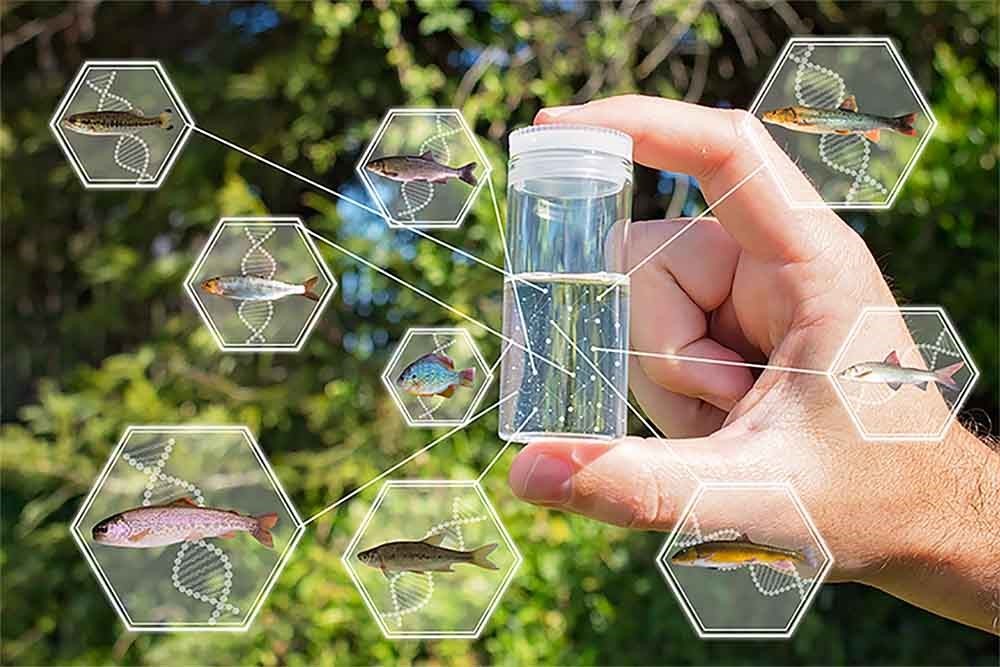Description

Disclaimer: Copyright infringement not intended.
Context
- Researchers at the Laboratory for the Conservation of Endangered Species (LaCONES), an arm of CCMB, have developed a novel method for assessing the biodiversity of ecosystems using environmental DNA (eDNA).
Details
Introduction to Environmental DNA (eDNA)
- Environmental DNA (eDNA) refers to genetic material obtained directly from environmental samples, such as water, soil, or air.
- It provides valuable insights into the presence and abundance of various organisms within an ecosystem without the need for direct observation or capture.
Applications of Environmental DNA
Biodiversity Monitoring
- eDNA is used to monitor and assess the biodiversity of various ecosystems, providing a non-invasive method for tracking the presence of different species, including endangered or elusive ones.
Aquatic Ecosystem Management
- In aquatic environments, eDNA analysis helps in monitoring fish and other aquatic organisms, assisting in the management and conservation of aquatic ecosystems.
Invasive Species Detection
- eDNA technology aids in the early detection of invasive species by identifying their genetic traces in the environment, enabling timely intervention to prevent ecological disruptions.
.jpg)
eDNA Sampling Techniques
Water Sampling
- Collection of water samples from lakes, rivers, or oceans for the extraction of DNA from various aquatic organisms, including fish, amphibians, and invertebrates.
Soil Sampling
- Extraction of DNA from soil samples to study the microbial communities and the presence of various organisms within the soil ecosystem.
Benefits of Environmental DNA Analysis
- Non-Invasive: eDNA analysis allows for the monitoring of ecosystems without directly disturbing the habitats or organisms, minimizing the impact on the environment.
- Cost-Effective: It offers a cost-effective method for biodiversity assessment and monitoring compared to traditional survey methods, which often require extensive fieldwork and resources.
- High Sensitivity: eDNA analysis is highly sensitive, capable of detecting even low concentrations of genetic material, enabling the identification of rare or elusive species.
Challenges and Considerations
- Contamination: Contamination of samples with exogenous DNA, including that from researchers or equipment, can lead to misleading results.
- Degradation: Environmental factors such as temperature and UV radiation can lead to the degradation of eDNA, affecting the accuracy of the analysis.
- Data Interpretation: Interpreting eDNA data requires expertise in both genetics and ecology, as well as an understanding of the specific ecosystem being studied.
Advantages Over Traditional Methods
- Cost-Effective and Efficient: The eDNA approach is a cheaper, faster, and scalable alternative to traditional methods, making it suitable for large-scale freshwater and marine ecosystem monitoring and conservation.
- Comprehensive Biodiversity Assessment: The method can detect a wide range of organisms, including viruses, bacteria, archaea, and eukaryotes such as fungi, plants, insects, birds, fish, and other animals.
Implementation and Findings
- Successful Application: The researchers tested the eDNA method in the biodiverse Chilika Lagoon ecosystem in Odisha, India, to assess its efficacy.
- Remarkable Results: Over 10 billion sequences of eDNA fragments were compared with a comprehensive database of reference sequences, revealing a total taxonomic diversity of approximately 1,071 families across the tree of life in the Chilika Lagoon.
- Implications for Conservation: This approach provides valuable insights for the monitoring and conservation of various ecosystems, offering a more comprehensive understanding of the diverse life forms present within them.

Conclusion
The innovative use of environmental DNA (eDNA) in biodiversity assessment, as demonstrated by the researchers at LaCONES, represents a significant advancement in the field of conservation biology. This approach not only provides a more efficient and cost-effective method for monitoring biodiversity but also offers a more comprehensive understanding of the intricate web of life existing within various ecosystems.
|
PRACTICE QUESTION
Q. Discuss the significance of environmental DNA (eDNA) in the context of biodiversity conservation and ecosystem monitoring. Examine its potential implications for the preservation of fragile ecosystems and the challenges associated with its implementation. (250 Words)
|














